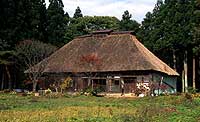
| Pseudonym reading | Time limit |
|---|---|
| Specified type | Country designated / important cultural property |
| Type | Building |
| Designated date | September 11, 1990 |
| Specified details | |
| quantity | 1 building |
| location | Kitakami city Wakamachi Iwasawa |
| owner | Izawa Fukuyo · Kunato Shrine |
| Holding group | |
| Management organization | |
| home page |
Overview
The Izawa family house is located approximately 15 km west of Kitakami City, and is close to a highway connecting Kitakami City and Yokote City in Akita Prefecture.
The main building is located south facing in the center of the site, and Kunadototo Satonomiya is located in the mountain forest northwest of the main building, and the approach is through the east side of the main building.
The Tamonin Izawa family was a master of the villagers who lived in the village (Sato Shuin) and had power in this area since the middle of the Edo period as a substitute for Sennin Human Rights (which will be Kunato Shrine after the Meiji era).
After the Meiji Restoration Shinto-Buddha separation and ban on study, he became a priest.
The architectural age of the main house is not clear, but it is considered to be the end of the 18th century or the beginning of the 19th century, where the Tamon-in was popular from the viewpoint of the structure and form of the building.
The main house is a 20.4 m grid, 11.2 m beam space, a parlor, and a fort building.
The floor plan of the building is the same as the farmer in this area, but it is characterized as a home of a practitioner.
A round pillar is set up in the room and at the dojo border, a large rainbow beam is erected, and using the method of the hall, both rooms can be used as one room.
Also noteworthy is the use of plaster sculptures on the walls of the rainbow beams and the walls on the inner side of the dojo.
Kunado Shrine Satomiya, located behind the main house, is the building upon which the study activities were based, and was erected in 1787.
The Tamonin Izawa Family House is one of the few remains of village training and has high value
